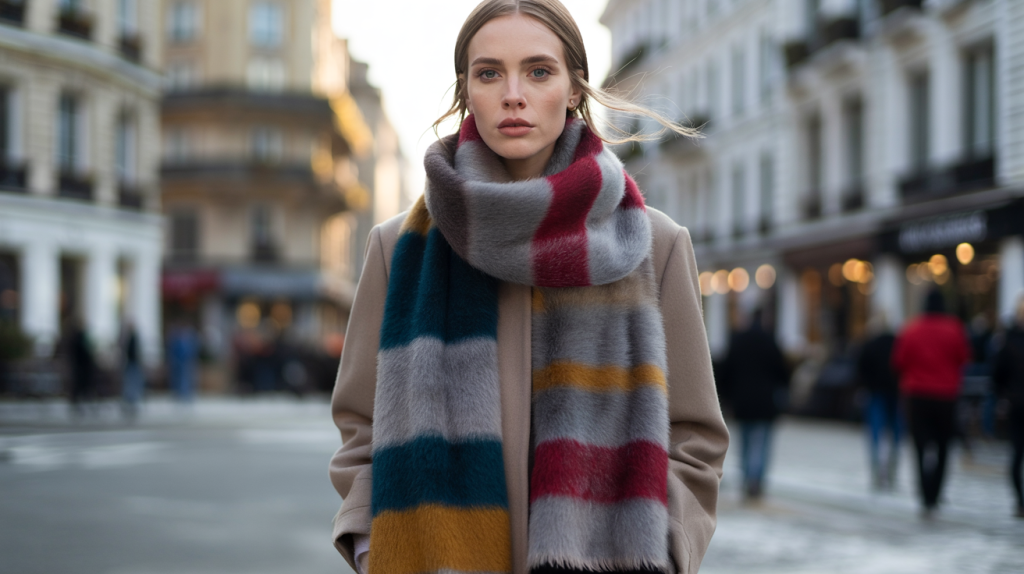Big, soft and a little dramatic, the oversized scarf has turned from cozy extra into headline piece. Type “écharpe oversize tendance” and the feed fills with giant wraps that elevate a coat, sharpen a hoodie and rescue cold commutes.
Here is why it spreads fast. Social platforms amplify bold textures and volume, while chilly seasons make practical layers feel smart, not fussy. TikTok confirmed it had more than 1 billion monthly active users in 2021, a massive engine for visual fashion cues that migrate to the street within weeks (Source : TikTok Newsroom, 27 September 2021). At home, the World Health Organization advises a minimum indoor temperature of 18°C for healthy adults, a simple benchmark that nudges many toward warm accessories rather than cranking the heating all day (Source : WHO Housing and health guidelines, 2018).
Écharpe oversize tendance : the look that works now
The main idea is balance. An oversized scarf adds volume where outfits often feel flat once the coat closes. It frames the face, creates a vertical line and hides a tired neckline in seconds.
The common hiccup is bulk without structure. If fabric is too stiff or too short, the scarf pops up like a float and fights with shoulder seams. Street shots that circulate every winter echo one simple fix: choose length first, then thickness. Aim for a wrap that reaches mid thigh so drapes fall clean, not stubby.
There is also a comfort angle that matters. Wool naturally manages moisture, which keeps the neck warm without clamminess. The Woolmark Company states wool can absorb up to 30% of its weight in moisture vapour before feeling wet, a technical edge that explains why it feels comfortable on busy days outside and in overheated transport (Source : The Woolmark Company, fibre facts).
How to wear an oversized scarf without looking buried
Start with the coat you actually wear most. Then test scale in front of a mirror, not on a hanger. A few fast moves solve 90% of styling doubts.
- The clean loop : fold the scarf lengthwise, drape around the neck, pull one end through the loop and let both ends hit the coat hem for a sharp line.
- The blanket fold : spread over the shoulders like a shawl, then pinch a small third of fabric under one lapel to create shape, not bulk.
- The cross-body tuck : throw one end across the chest and slip it under the opposite arm, ideal with a blazer to keep hands free.
- The high stack : wrap twice to sit just under the chin, then fan the top edge slightly. Works with a beanie without flattening hair.
- The belt trick : drape long, add a slim belt over the scarf at the waist. It turns a puffer into a cleaner silhouette.
A quick note on color. Two-tone checks or soft heathers play well with winter neutrals. If a coat is loud, go solid. If the coat is quiet, try brushed stripes for texture that reads on camera and in real life.
Materials and sizes that actually feel good
Wool, cashmere, mohair and blends each bring a different hand feel. Pure wool is resilient and breathable. Cashmere is lighter for the same warmth, best when the weave is dense so it does not collapse at the neck. Mohair brings the halo effect that photographs beautifully, with a fuzzy finish that still traps warmth.
Numbers help. For a true oversized wrap, look for lengths around 180 to 220 cm and widths between 35 and 50 cm so you can loop once without a stiff knot. If tags mention fabric weight, mid to heavy knits often sit around 250 to 350 gsm, a sweet spot for drape that does not sag.
Care impacts longevity. The Woolmark Company recommends cool hand wash or a gentle wool cycle around 30°C, plus flat drying to keep shape, which preserves loft and reduces pilling over time (Source : The Woolmark Company, care guidance). That small routine keeps the scarf fresh, so it stays in rotation instead of the back of the chair.
Care, budgets, and a smarter buy for the long winter
There is a simple checklist when adding one to cart. Touch test matters more than any label line. Fibres should spring back after a squeeze, not stay crushed. Check the ends for neat finishes, since messy tassels fray fast.
If sensitive skin is part of the story, scan for certifications that screen harmful substances. OEKO TEX Standard 100 has been in place since 1992 and signals that every component of the textile was tested, from yarn to label tag (Source : OEKO TEX Association, 1992 foundation note). It is not a quality grade, it is a safety net.
One last fix many regret skipping. Store the scarf folded, not hung, to avoid stretch lines at the middle. A zip pouch during travel keeps lint away from knits. Small moves, long life. And if in doubt between two sizes, most stylists reccomend going slightly longer, because extra length can be tucked, while short fabric cannot be stretched.
